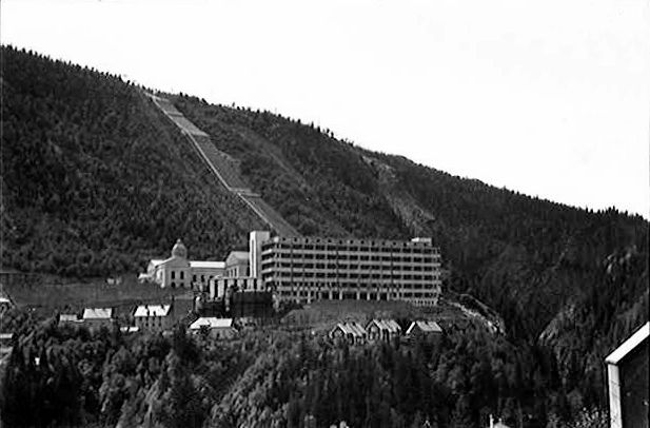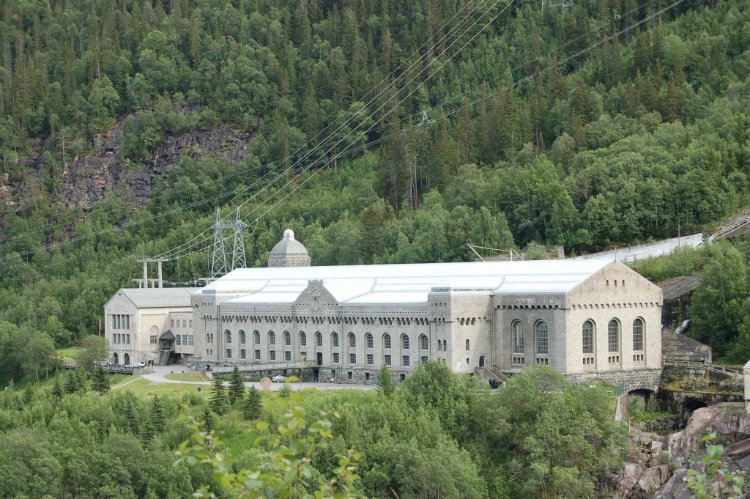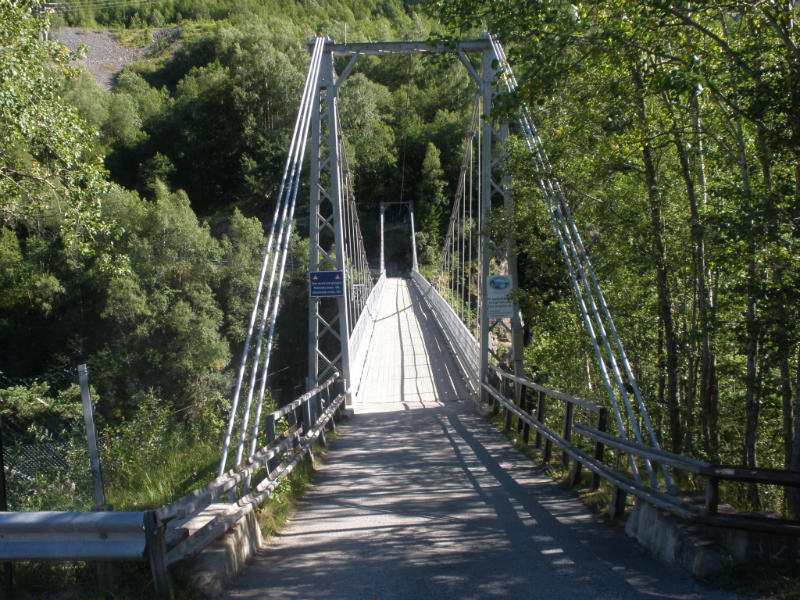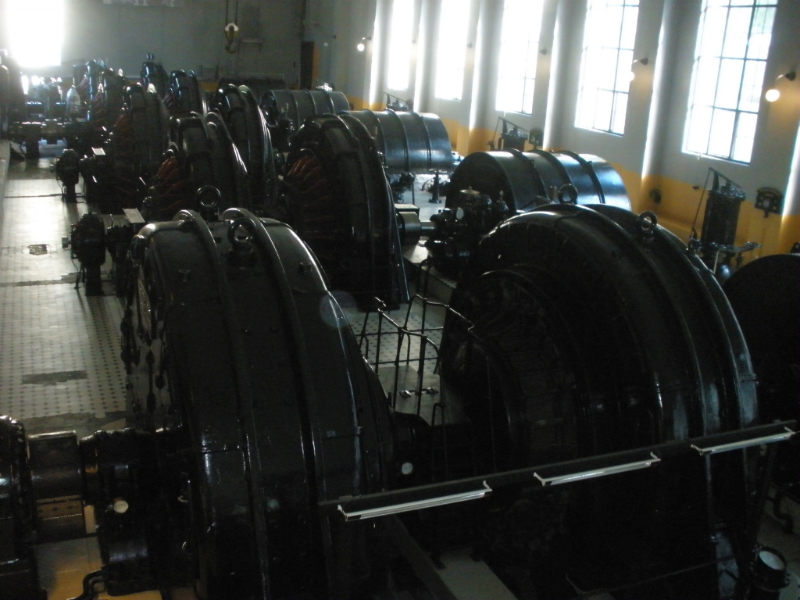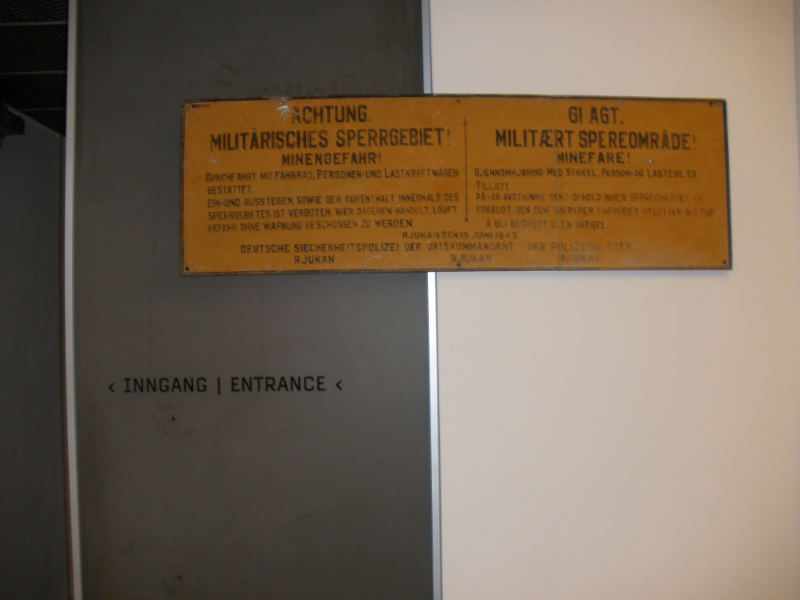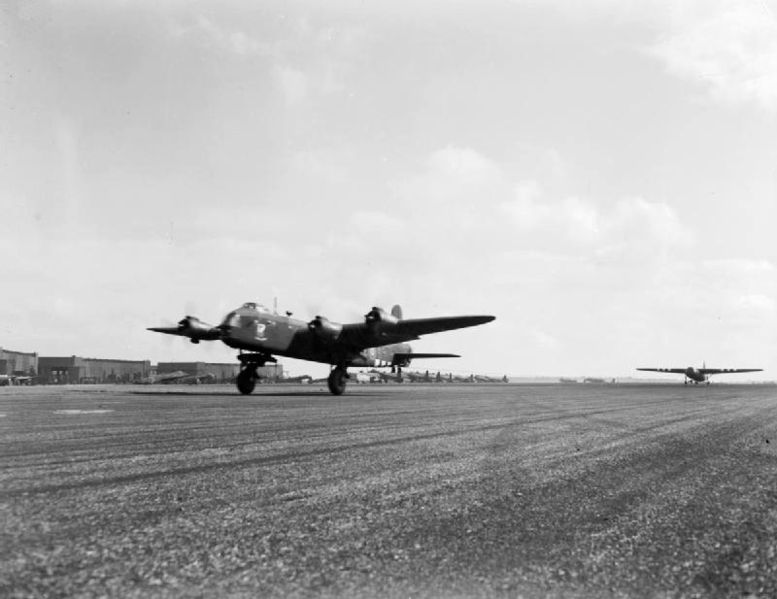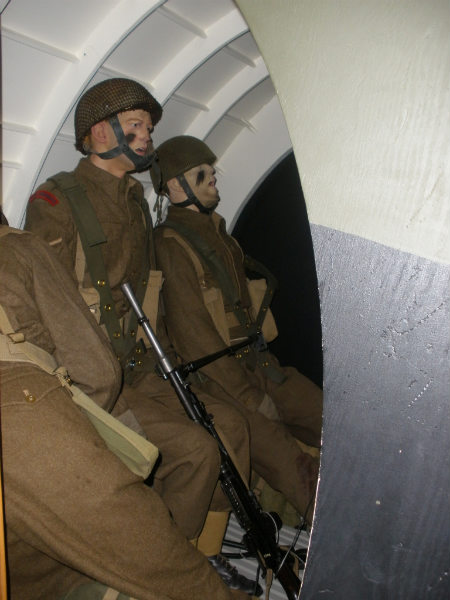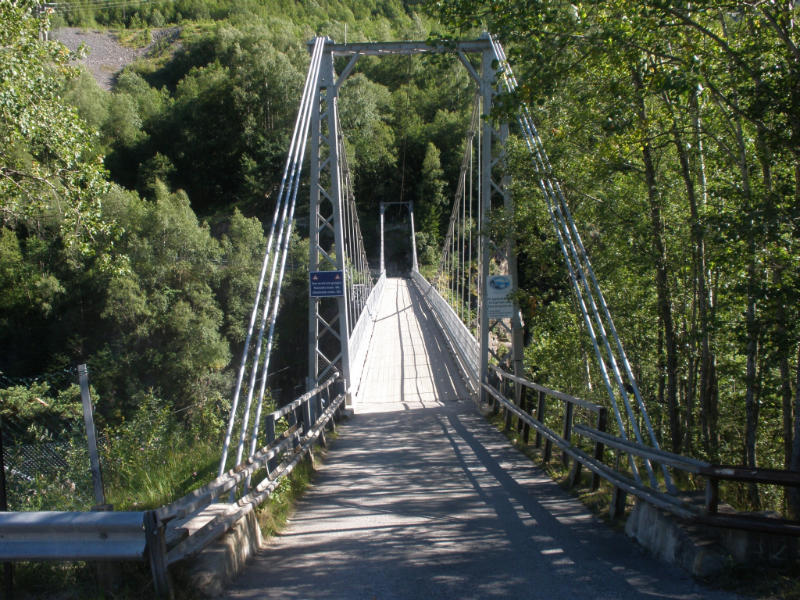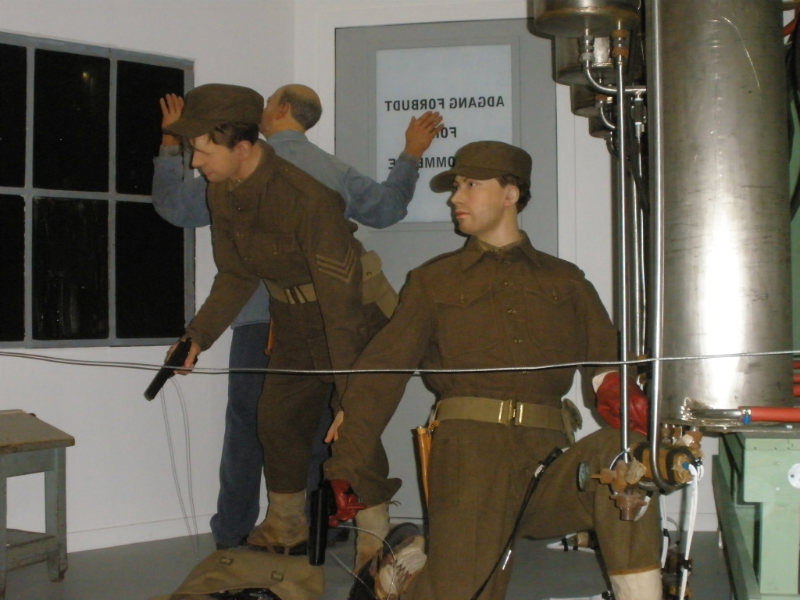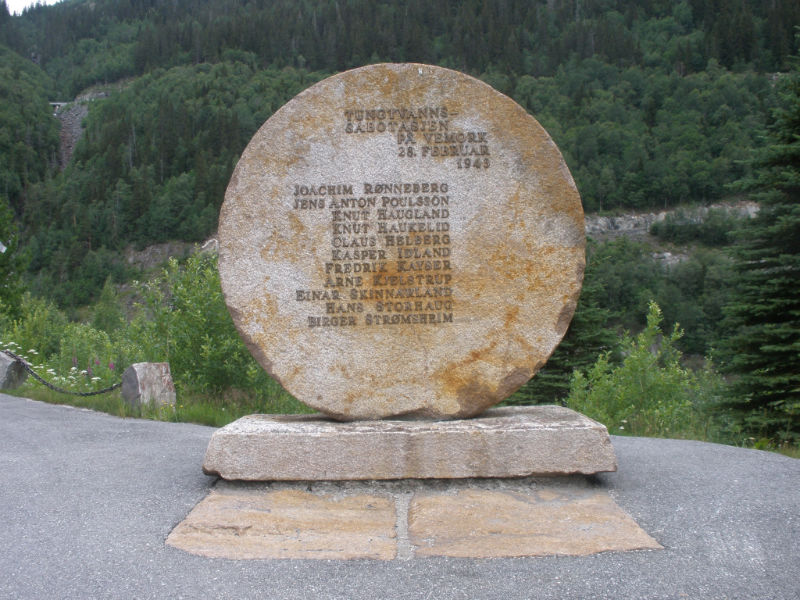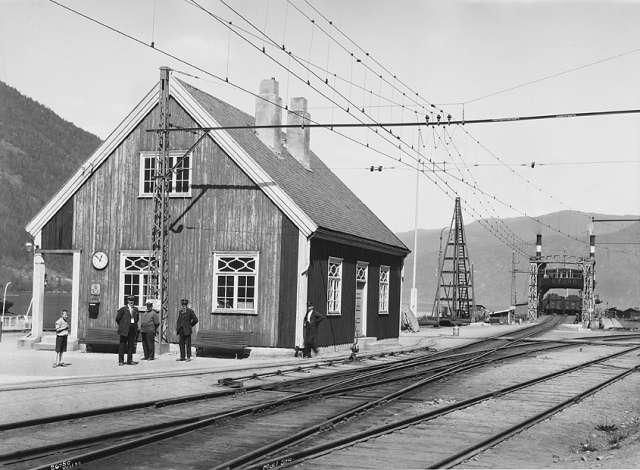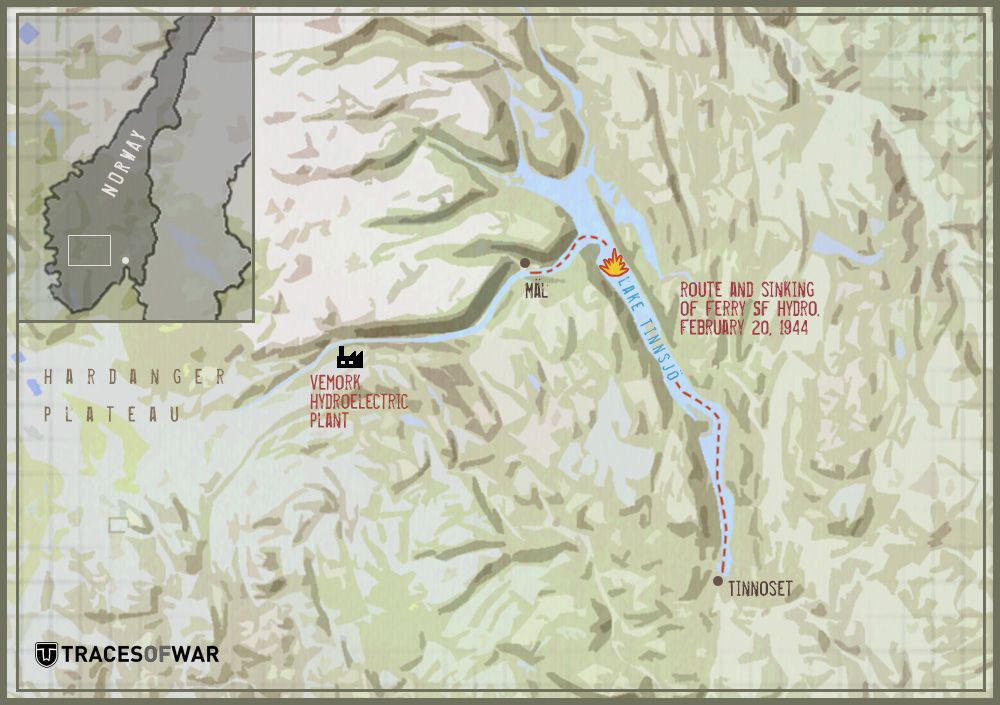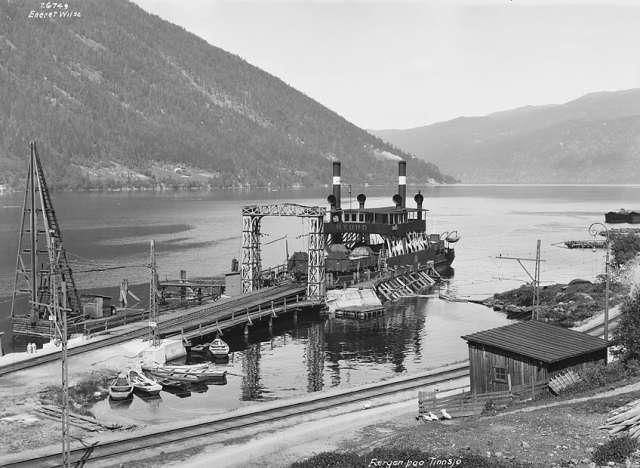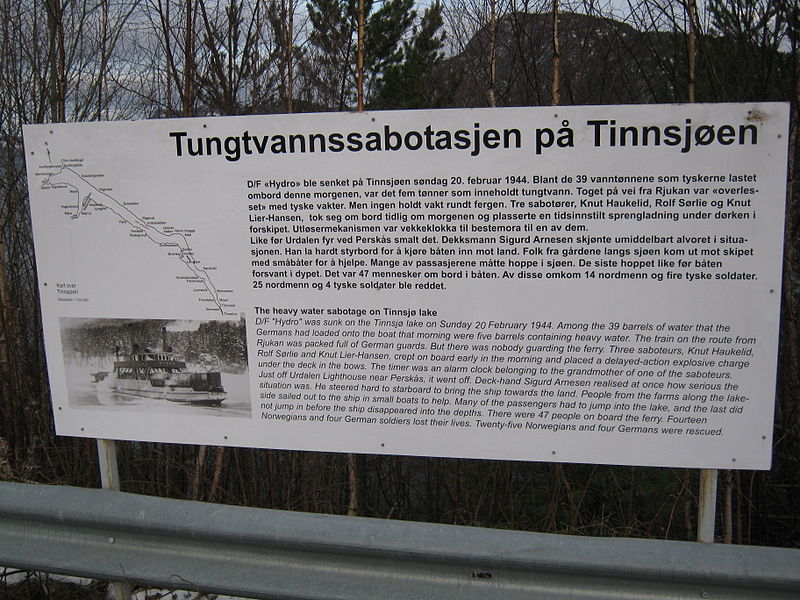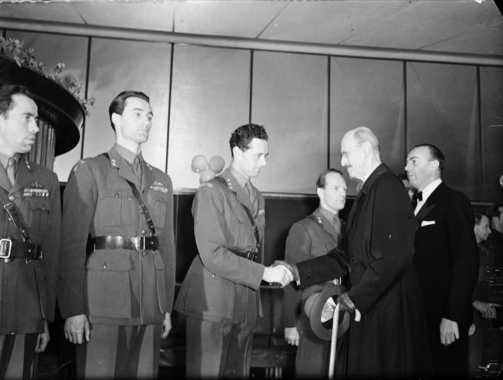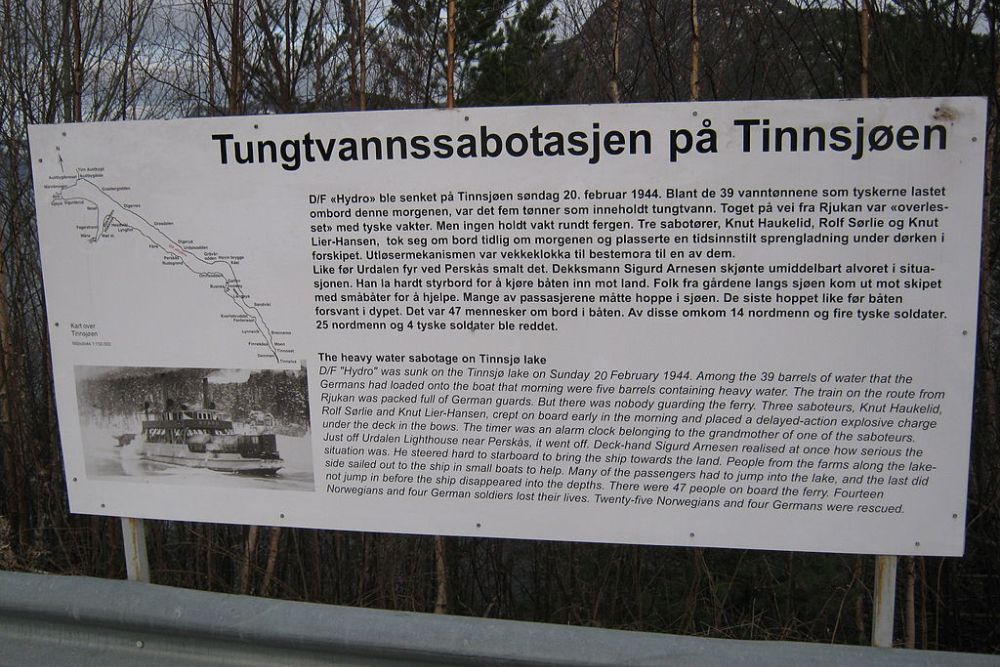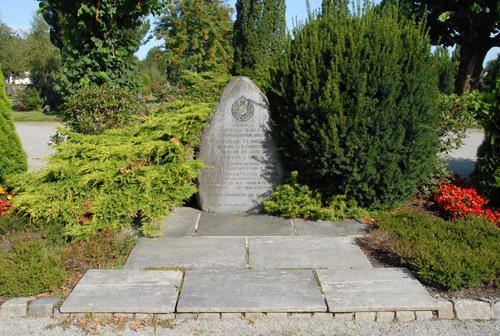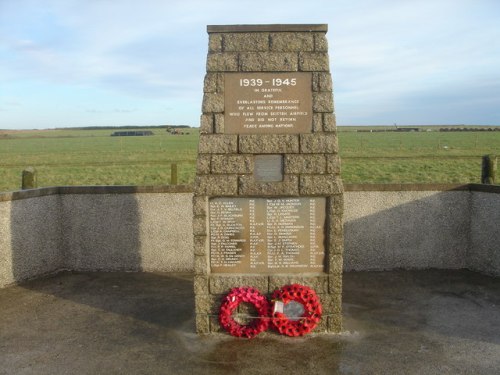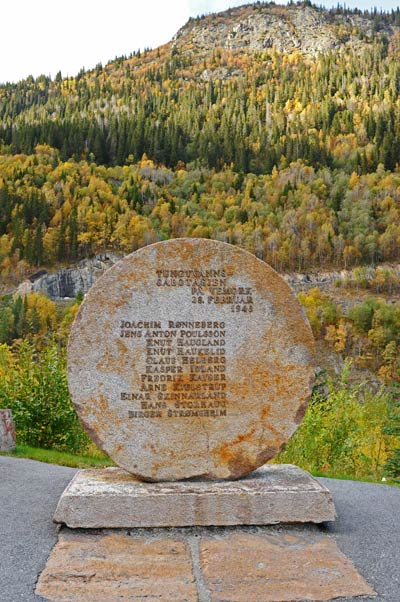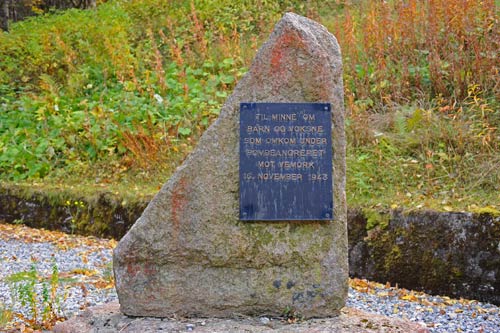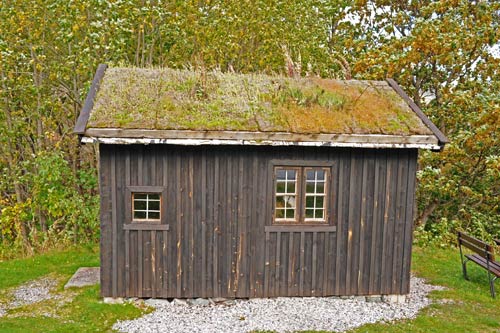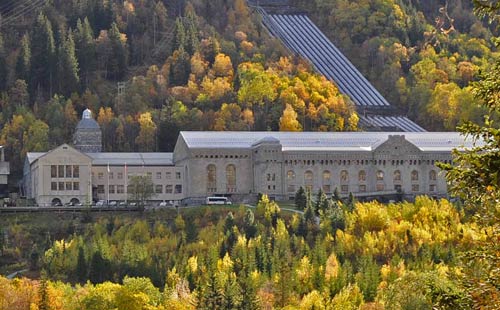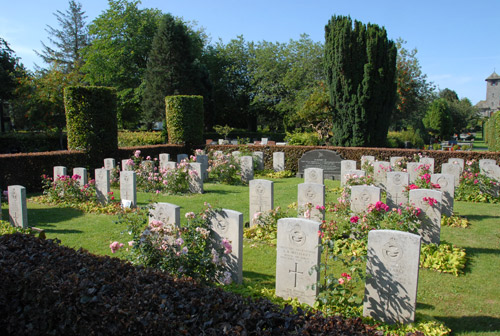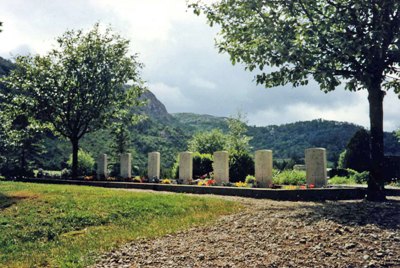Introduction
"We were not informed about production of heavy water in Vemork. We were not informed about the Germans wanting to use heavy water for the development of an atomic bomb. Before leaving England, we were told our action had the highest priority but we were not aware how great the influence could be on the outcome of the war." as Joachim Rönneberg and Birger Strömsheim declared in 1989. They belonged to a group of Norwegian commandoes who were involved in one of the most daring operations during World War Two: the attempt at sabotage of the production of heavy water in the Norwegian town of Vemork.
Images
Previous history and planning
Previous history
After the Americans and the British had discovered in 1942 that the development of an atomic bomb was feasible their greatest fear was that Germany would develop such a weapon; in particular because it was assumed that the country was way ahead in the field of nuclear physics. In 1942, the British and Americans still thought Germany was two years ahead of them. After all, Germany did have uranium at her disposal from the mines in the occupied areas in Czechoslovakia and the German scientists were held in high regard.
An essential element in German nuclear research was heavy water. Heavy water or deuterium oxide is physically similar to "normal" water – hydrogen oxide - but the deuterium molecule is twice as heavy as the hydrogen molecule. Therefore its specific weight is about 10% higher than normal water. The nucleus consists of one proton, one neutron and an electron as compared to an hydrogen atom which has no neutron. Normal water contains a small amount of heavy water but it is difficult to separate the two substances. Before and during World War Two, this was only possible in the hydroelectric plant of Norsk Hydro in Vemork in the Norwegian province of Telemark. Heavy water was separated here from normal water by means of electrolysis. At Norsk Hydro, it was created as a byproduct in the production of ammonia, a raw material for the production of artificial fertilizer. Before the war, there was hardly any use for heavy water but scientists were highly interested in the characteristics of the substance.
Heavy water can be used for instance to slow down the movement of neutrons in a uranium pile. Thanks to this braking effect, it can improve nuclear fission and create a chain reaction. A negative catalyst like that, called a moderator is therefore essential in constructing a nuclear reactor. The Americans by the way, used graphite as the moderator in their reactors of the Manhattan project. On December 2nd, 1942, Italian nuclear physicist Enrico Fermi managed to create the first chain reaction in such a reactor. The Germans thought graphite would not be suitable as moderator and therefore attempted to build a heavy water reactor. The scientists wanted to conduct preliminary experiments first in the hope to acquire plutonium this way. The Allies were aware of the German plans concerning heavy water and even prior to the war, they attempted to prevent Germany from laying her hands on the substance. In 1939, the French secret service had smuggled the available stock of 48.86 gallons of heavy water out of Norway to France and subsequently to Great Britain.
After Norway had been captured and occupied by Germany in April – June 1940 in Unternehmen Weserübung, the Germans ordered to increase the production of heavy water in Vemork. In February 1942, this amounted to 1.320,57 gallons.
Planning
The Americans and British knew for instance from intelligence they received from the Norwegian resistance, the Germans were making lots of efforts to acquire heavy water. Therefore they decided the production capacity in Norway had to be destroyed. Norwegian professor Leif Tronstad played an important role in the preparations for sabotaging the production of heavy water. Before the war, he was employed at the Norwegian Institute of Technology in Trondheim and was an expert in the field of heavy water and in that capacity he had been involved in the construction of the plant at Vemork. In October 1941, when he risked being arrested by the Germans, he had fled to Great Britain via neutral Sweden. With the help of a resistance group that had a secret transmitter at its disposal, he had forwarded information about the plant in Vemork, among other things. After his escape, he kept in touch with Jomar Brun - via the S.O.E. network - the manager of the plant and a close friend of his.
The electrolysis plant in Vemork was housed in a complex built on a slope at an altitude of 984.25 feet. The only access to the plant was by a suspension bridge across a ravine. The town of Rjukan was situated at the other side of the valley. Manager Brun and other employees who sympathized with the resistance sabotaged the production of heavy water by adding castor oil to the electrolysis tank, causing the water to foam heavily. As a result, the production had to be interrupted frequently. The heavy water that was eventually produced was contaminated so it had to be purified first before it could be used.
In mid 1942, the British government decided this was not enough and that the plant at Vemork had to be destroyed. Various options were considered. A bombardment by the R.A.F. was rejected because in particular in an attack by night, it would certainly be difficult to locate the plant, let alone hit it. Tronstad also pointed out that the tanks containing liquid ammonia might well be damaged in a bombardment which could result in grave danger for the population. It was also considered to drop a group of British commandoes on Lake Møsvath using Consolidated PBY Catalina amphibious aircraft. This plan was canceled when it turned out these Catalina’s could not land on ice. Eventually, Combined Operations came up with an audacious plan. Two Handley Page Halifax bombers were to tow one Horsa glider each from their base in Scotland to Norway, a distance of hundreds of miles.
Each glider would carry two pilots and 15 Royal Engineers of the 9th Field Company and the 261st Field Park Company. Both companies were part of the British 1st Airborne Division. The plan was, once they had landed on Lake Møsvath, they would use folding bikes to go to the plant. The German guards had to be eliminated. Once they had broken into the factory they would destroy the equipment and the stock of heavy water. Subsequently, the unit would split in three groups and make for neutral Sweden. In fact this would be the first time the British would use gliders in an airborne operation. Previously, they had deployed parachutists only. It was rejected this time because in that case the men would have to carry a load much too heavy and because a drop entailed the risk of the para's landing too far apart. One group of commandoes was commanded by Lieutenant A.C. Allen, the other by Lieutenant M.D. Green who was replaced later by Lieutenant D.A. Methven. In planning the raid, it was assumed that each team should be capable of carrying out the operation which was given the code name Operation Freshman.
S.O.E. Norwegian section advised against this plan. According to the employees, too much depended on good weather, moreover because the weather was usually bad on the Hardanger plateau (Hardfangervidda in Norwegian). The local weather was characterized by dense clouds and high winds. They also considered the landing zone too hard to find and expressed doubts whether the ice on the lake would be thick enough to take the weight of a fully loaded glider.
On March 28th, 1942, Norwegian S.O.E. agent Einar Skinnarland was dispatched to Telemark as first scout. He came from the region and he knew some employees of the power plant in Vemork, including his brother Torstein. Einar himself was also employed at the plant as a technician. He charted the German defenses of the plant and forwarded the information to the S.O.E. In October, the German garrison in Rjukan and Vemork numbered some 60 men.
Definitielijst
- Horsa glider
- British glider used by the Allies for air landing operations to transport troops and vehicles. It was towed close to its target and released, after which the glider pilot would try to land as near to the target as possible. After a rough landing the troops and vehicles could disembark. It could carry up to 20-25 troops or 3,241 kg of payload.
- Manhattan project
- The American development of the Atomic bomb during World War Two.
- mid
- Military intelligence service.
- raid
- Fast military raid in enemy territory
- resistance
- Resistance against the enemy. Often also with armed resources.
Images
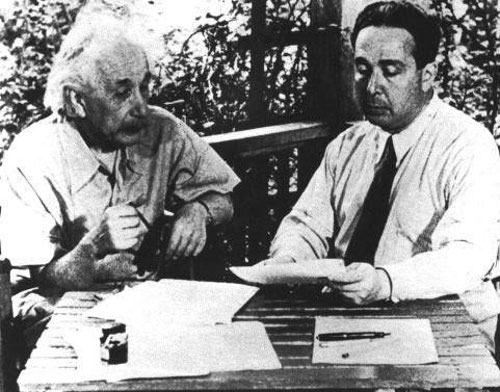 As early as 1939, Albert Einstein (left with Leo Szilard) wrote a letter to President Roosevelt warning him for the development of an atomic bomb by Germany. Source: Osti.gov.
As early as 1939, Albert Einstein (left with Leo Szilard) wrote a letter to President Roosevelt warning him for the development of an atomic bomb by Germany. Source: Osti.gov.Operations Grouse and Freshman
Operation Grouse
Prior to Operation Freshman, four Norwegian scouts would be dropped. They were to provide information on the weather and the German defense. They also were ordered to cut telephone lines and to mark the landing zone. This operation was given the code name Grouse. The team of scouts, designated Swallow consisted of 2nd Lieutenant Jens-Anton Poulsson, Sergeant Arne Kjelstrup, wireless operator Sergeant Knut Hauglund and Sergeant Claus Helberg. Prior to being dropped, the Norwegian commandoes took an S.O.E. training course and were taught to use radio transmitters, how to handle explosives and survival skills. All four had been born in Telemark. After they had fled to Great Britain following the German occupation they had joined the Norwegian Independent Company, also known as Kompani Linge. All four were familiar with the area and experienced skiers. Only Poulsson knew the target of the operation although he admitted after the war he had not known to what purpose exactly the Germans would need heavy water for. The others thought they were to train people for the armed resistance in Norway. At the end of August 1942, they were ready to go. Two efforts were made but both times the men could not be dropped over Norway because the aircraft had technical problems or the weather over the drop zone was too bad. Finally on October 18th, 1942, they were dropped successfully from a Handley Page Halifax. On landing they discovered they had not been dropped on the planned location. They should have been dropped over Ugleflott, a swampy area on the Hardangervidda but instead they landed on a slope strewn with rocks in the vicinity of a mountain cabin, known locally as the Fjarefit. It took them two days to recover the 12 containers in the snow covered terrain holding their supplies and equipment, more so because their skis had been packed in the last container they found.
Meanwhile, the men knew they were 9.94 miles west of their designated drop zone. Subsequently they had to traverse 62.14 miles of inhospitable terrain to Lake Møsvatn. This was made more difficult because they had to transport 716.5 lbs of equipment. The maximum a skier could carry at this altitude was 72.75 lbs, meaning they had to travel each stage of the route three times in order to transport everything. The snow conditions were not good either with water beneath. They also lost much time gathering wood for fire as the fuel for their burner had been lost in the drop. The men were therefore unable to advance more than a few miles each day. On crossing a frozen lake, Poulsson fell through the ice but fortunately, his colleagues managed to pull him out in time. They spent the night in uninhabited mountain cabins. On October 30th, they reached a cabin locally known as Reinar. Here they rested for a few days. Initially they failed to contact London by radio as the battery was dead.
The next day, they reached Grasfjell cabin near Lake Sandvatn. That would be the springboard for the operation. Using a battery acquired by Torstein Skinnarland, Einar’s brother and a self constructed aerial, they finally managed to contact London by radio. The men began preparing for the operation. They selected a landing zone some 3.11 miles from the Møsvatn dam and about the same distance from Vemork. They were to mark the area with lamps and a Eureka wireless transmitter which sent out a signal that would be picked up by the airplane. This would make the landing zone easier to find for the pilots. Life in the cabin was not easy. The temperature outside dropped far below zero. They also lived in twilight continuously. The Rjukan area, due to its northerly location and the fact that the place is surrounded by mountains, lies in shadow from September to March. The men mainly ate soup made of dried fish.
Operation Freshman
While the Norwegian scouts were waiting on the Hardanger plateau, the preparations for the operation continued. The engineers who would carry out the raid, underwent training in Fort William in Scotland. To this end, scale models were made of the installation they were to demolish. In Port Sunlight, they were taught to blow large tanks in which the heavy water was stored. At the end of October, their training was finished. The operation would be launched in the next period of full moon, starting on November 17th.
The launch of Operation Freshman was set for November 19th, 1942. The weather was not ideal, both in Great Britain as well as in the target area because of the dense clouds. As the weather forecast was even worse, the officers of Combined Operations decided the operation would take place on that day nonetheless. The first combination of a Halifax and its glider took off at 17:50 hours from R.A.F. Skitten in Scotland, the second at 18:10. The bomber crews had little experience flying Halifaxes; the Horsa pilots were experienced but they had hardly been able to train prior to the mission. Moreover, communication between bombers and gliders was impossible as both telephone lines proved to be defective. They reached the Norwegian coast at Egersund.
The Halifax that took off last (witth pilot Flight Lieutenant Roland Parkinson) reached the target area. However, despite several attempts, they could not get close enough to the landing zone to release the tow. Because the fuel position deteriorated, Parkinson decided to abort the mission. During the return trip, the tow cable broke at 11:40 PM due to ice build-up. The Halifax then flew lower. Probably in the hope of determining the location where the Horsa ended up. During that attempt, however, the bomber crashed into the Hæstadberg, killing all six crew members. In the emergency landing of the glider, both pilots and one engineer were killed and the other commandoes were seriously injured. Two soldiers managed to escape from the wreckage and reached a village. They asked the local people for help. The nearest physician however lived in Egersund, 9.32 miles away. He could only be reached by telephone. This meant automatically the Germans would be informed as well. Nonetheless, the British agreed because they thought they would be considered regular prisoners of war. The next day, the survivors were arrested by the Germans and taken to a camp in Slettebö. After a short interrogation they were executed pursuant to the Kommandobefehl Hitler had recently issued.
The first Halifax did manage to reach a sufficiently high altitude. During the flight however, it was discovered that the Rebecca receiver, which was to pick up the signal from the Eureka transmitter, was inoperable. Subsequently, the crew attempted to find the landing zone on a map. The dense cloud cover made this all but impossible though. The aircraft flew over the target area for a while. When the pilot had worked out his position, it transpired, considering the amount of fuel remaining, it would be impossible to find the landing zone and subsequently make it back to Scotland. He therefore decided to return with the Horsa still in tow. Meanwhile, icing had occurred on both aircraft so the Halifax was forced to descent. This however made both aircraft vulnerable to the treacherous wind sheer the Hardanger plateau is known for. Due to the force of this wind and the icing, the towing cable snapped around 23:55. The Horsa crashed on a mountainside near the Lysefjord; the Halifax made it to its base in Scotland.
As a result of the crash of the Horsa, eight men were killed instantly, four were seriously injured and five escaped unscathed. Two of them managed to reach a farm house where they asked for help. The local population sent out a rescue team. The men indicated they wanted to go to Sweden. The Norwegians said it was impossible however, due to the long distance to the Swedish border and the injuries of the engineers. The population attempted to keep the crash secret: they burned all documents and maps from the plane. The next day however, members of the Wehrmacht and the SS arrived in the area and arrested the survivors. The Germans buried the dead on the spot. The seriously injured were later murdered with an injection by a military physician in the prison hospital in Stavanger. Their bodies were weighted with stones and dumped in the sea. The healthy survivors were deported to Grini concentration camp and executed on January 18th, 1943. Prior to this, the British had been severely tortured to force them to reveal details of their mission.
News about the events in Norway were received piece meal in London. On December 11th, 1942, an S.O.E. agent reported that both Horsas and one Halifax had crashed and all survivors had been executed. Despite the fact that British commandoes and Norwegian civilians had taken much trouble to destroy all documents and maps pertaining to the operation, they had missed one map. The Germans found it and concluded that Vemork had been the designated target of the operation. Guarding the installation was improved. Despite its failure, Operation Freshman showed that such a commando raid could very well be carried out. Many valuable lessons were learned and were put to good use later in the war.
Hibernation
The failure of Operation Freshman made Poulsson and his men realize they had to stay longer in the area than foreseen. From London they received orders to move into the mountains and await further orders. At the end of November 1942, the Swallow team relocated to Lake Store Saure, 18.6 miles northwest of Rjukan. They found shelter in a hunting cabin that had been built by Poulsson before the war. They called it the Fetter cabin; today it is known as the Svensbu cabin. The men kept alive with what little food remained of the stock that had been dropped in October. Torstein Skinnarland also provided some fresh food from time to time but he was arrested by the Gestapo at the end of November. This meant they had lost this source. The next days, the men sustained themselves on reindeer moss but it was not sufficient. The men lost weight and began suffering from hunger edema. Their strength decreased visibly. Temperatures at night dropped to minus 30 degrees. Poulsson was the healthiest of them. He went hunting every day, hoping to shoot a reindeer to provide the necessary food for the Norwegians. Just before Christmas, he was lucky. He shot a reindeer at some 6.21 miles from the cabin. He brought part of the meat and the organs back. The stomach and then in particular its partly digested contents had a high nutritional value and contained many vitamins the men were short of. The brain, the eyes, other organs and the marrow in the bones were a welcome source of food. The health of the other members of the group improved quickly because of the new food. Over the following months, they managed to shoot a number of reindeer, enabling them to make it through the winter, although the food remained very one-sided. The months-long stay in the small hut also caused mutual tension within the team.
Definitielijst
- concentration camp
- Closed camp where people are being held captive that are considered to be anti- social, enemies of the state, criminal or unwanted individuals. These groups mostly do not get a fair trial or are condemned to doing time in a camp.
- raid
- Fast military raid in enemy territory
- resistance
- Resistance against the enemy. Often also with armed resources.
- Wehrmacht
- German armed military forces, divided in ground forces, air force and navy.
Images
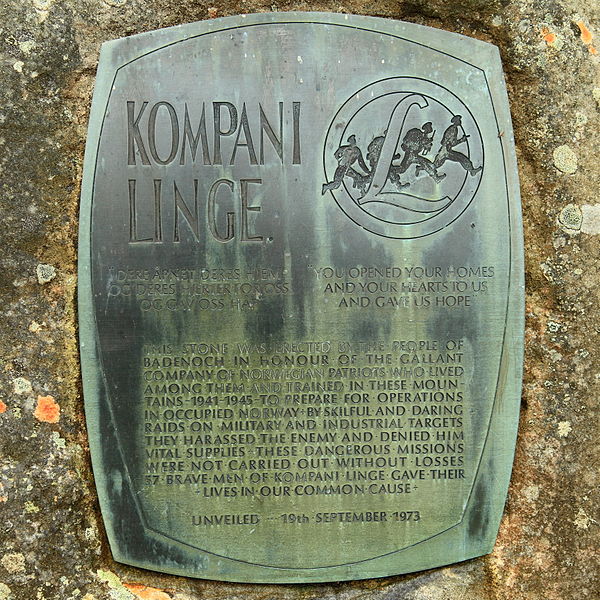 Plaque in memory of the Kompanie Linge in Glenmore Forest Park Scotland Source: QuentinUK (CC BY-SA 3.0).
Plaque in memory of the Kompanie Linge in Glenmore Forest Park Scotland Source: QuentinUK (CC BY-SA 3.0).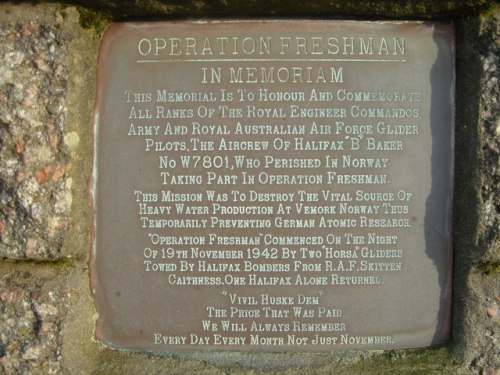 Plaque at Skitten Airfield (Scotland) in memory of the dead during Operation Freshman Source: David Glass (CC BY-SA 2.0.
Plaque at Skitten Airfield (Scotland) in memory of the dead during Operation Freshman Source: David Glass (CC BY-SA 2.0.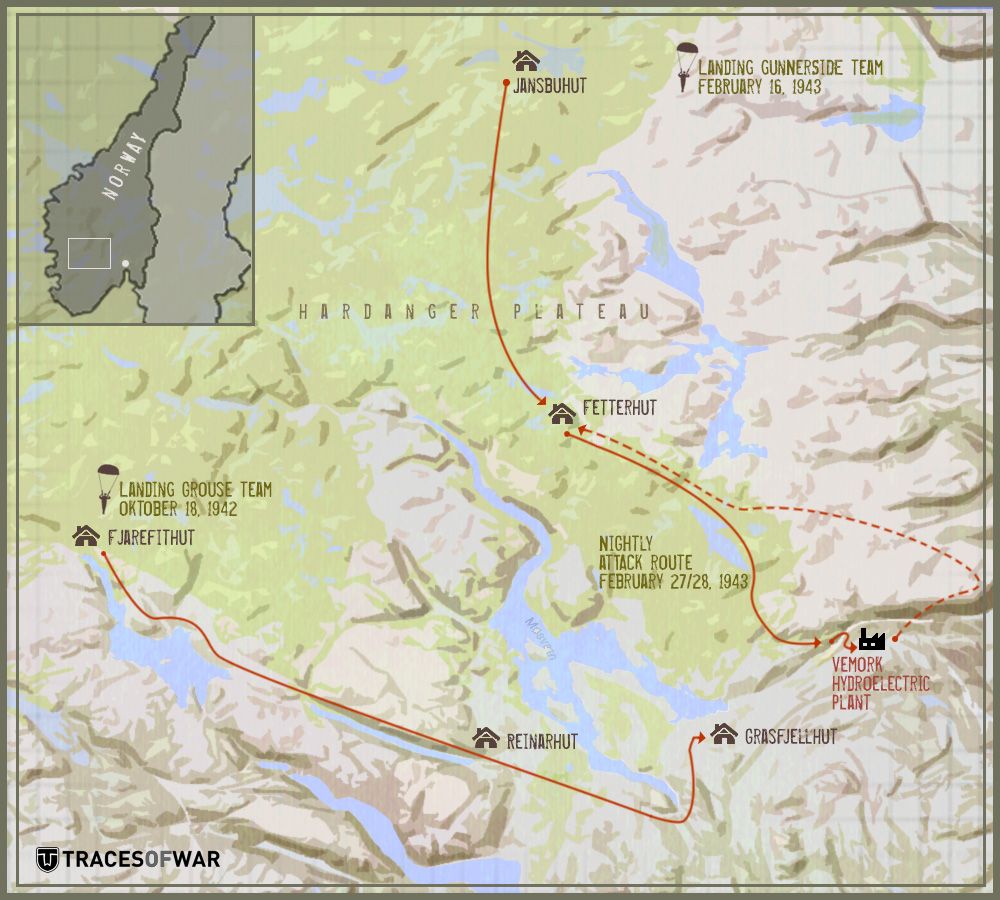 The routes taken by the teams of Operation Grouse and Gunnerside to the factory in Vemork. Source: Roger Paulissen, TracesOfWar.
The routes taken by the teams of Operation Grouse and Gunnerside to the factory in Vemork. Source: Roger Paulissen, TracesOfWar.Operation Gunnerside
Despite the failure of Operation Freshman, the British and Americans remained determined to destroy the installation at Vemork. Following the suggestion of former plant manager Jomar Brun, who had meanwhile fled to Great Britain, the British decided the next attack could be best carried out by a small group of Norwegian saboteurs. Lieutenant Joachim Rönneberg was appointed leader of the operation; he was selected by S.O.E. for his balanced personality and good qualities of leadership. He was to recruit a group of five volunteers from Kompanie Linge in Glenmore camp, an army unit consisting of Norwegians who had fled their home country. He selected Lieutenant Knut Haukelid, Sergeant Fredrik Kayser, Lieutenant Kasper Idland, Sergeant Hans Storhaug and Sergeant Birger Strömsheim. They were given special training for which even a scale model of the electrolysis plant was built at the S.O.E. facility in Brickendonbury Manor in Hertfordshire. They had to learn every detail by heart. After the war, Rönneberg declared about this: "With the arrival of Jomar Brun, all blueprints of the factory had also arrived and I can safely state that not a single operation that has been carried out from England in this period, had so many details at its disposal than ours. Not one of us had ever been inside the plant but when we left England, we knew more about it than anyone else." George Reahm, the officer in charge at Brickendonbury Manor stated that he had never seen such professional men, "This was an excellent group in every respect."
Just before Christmas they were going to leave for Norway for the performance of Gunnerside. Tronstad came to Tempsford base to say goodbye. He emphasized the importance of the mission, but also reminded them of the fate of the participants in Operation Freshman, to emphasize the risk they faced. Finally, he said: "For those who have gone before you and who have died, I urge you to do your utmost to make the operation a success. You don't know exactly why it is so important, but believe me, your actions will still live on in history a century from now." However, it ended in an anticlimax. Due to bad weather they could not leave. This happened several more times in the coming weeks. For the next drop, that would take place on February 16th 1943, it was agreed upon the men would jump anyway, even if there was no contact with the reception committee. On February 16th, the weather was favorable. Tronstadt addressed the men shortly before departure: "Unfortunately I cannot tell you why this mission is so important but if you succeed, you will live forever in Norwegian history, so good luck and be strong." Prior to departure, they were each handed a suicide capsule. The drop proceeded very well. They came down at Lake Stricken, some 31.07 miles from the Fetter cabin. They recovered the supplies from the 11 containers that were dropped with them. They took some of it along and buried the rest on the spot. They found shelter in a cabin, designated the Jansbu cabin, standing at some miles from the lake. They did not know exactly where they were. The area was difficult to identify as everything was covered by a thick layer of snow. The next day the men tried to contact Poulsson but they had to abort the attempt because of a snow storm. This storm lasted no less than five days. Only then could the group embark on the journey to the Fetter cabin. A local poacher acted as their guide.
As soon as Poulsson’s and Rönneberg’s men had met they started preparing for the operation. The team was split in two, one would occupy itself with the sabotage, the other was to provide cover. Haugland and Skinnarland left for the Jansbu cabin in order to maintain radio contact with London. There were a few ways to approach the plant. They could take the route across the suspension bridge but it was heavily guarded. They also could use a narrow trail that ran around the mountain via which they could reach the factory from above. This route was also rejected because of the presence of mine fields. After a reconnaissance, Helberg came up with a new idea. He suggested to descend into the valley, climb the hill on the other side and then enter the building by way of an unguarded railway entrance. The ravine measured some 656 feet in depth. Helberg reconnoitered the route through the valley. He discovered both slopes were covered in trees and bushes and contained many fissures. Experienced as they were they should be able to descend and climb these slopes. Helberg’s idea was accepted. They depended heavily on the weather. If much snow would fall, their supports on the slopes would disappear. In case a warm squall would blow through the valley, the mission would have to be cancelled also because of the amount of melting water streaming down the slope.
Shortly before departure, Poulsson drew the men’s attention to Hitler’s Kommandobefehl. He advised them to commit suicide if they risked being taken prisoner. In the night of February 27th, 1943, the sabotage team left the Fjosbudalen cabin on skis, which had been chosen as the spring board for the operation. They took a steep downhill route. Poulsson noticed from the warm and humid air a squall was approaching. If it really started blowing, this would make the snow soft and slushy, making skiing difficult. Frozen rivers would be covered in water making crossing them even more difficult. The team of skiers were already impeded by the bad snow conditions. On a few occasions they sank down to their waist. At their depot near a dirt road, they left their skis, coveralls and rucksacks behind. They were now dressed in British uniforms. They hoped the raid on the installation would be considered a British operation and so prevent reprisals against the local population. The men were armed with a Thompson submachine gun, a Colt .45 caliber pistol (these weapons were chosen because they used the same ammunition and because the Thompson was more precise and reliable than the Stengun) and hand grenades. Two of them carried the explosives. When they descended into the valley, they saw thaw had set in, melting water was coming down the slopes and there was water on the frozen lake. They climbed the 656 feet high slope on the other side. After an exhausting trip of three hours they reached the railway line and approached the plant in a spread out formation.
At 00:30 hours, the sabotage team had reached the entrance to the plant’s premises. Kjelstrup broke the padlock of the gate that gave access to the railway line. The others waited a few hundred yards away. After this was completed, Kjelstrup left the premises to keep an eye on the German guards near the locks, some 300 yards up the mountain. Helberg took the watch near the gates to cover the withdrawal. Storhaug kept an eye on the guards near the bridge. Haukelid and Poulsson went to the German barracks adjacent to the plant and hid behind a few storage tanks. Should the Germans come out in case of an alarm, they would open fire on them. Rönneberg, Kayser, Strömsheim and Idland approached the building housing the electrolysis plant. The door was locked but Rönneberg and Kayser managed to enter the building through a cable duct. Brun had drawn their attention to the existence of this inspection duct one man at a time could crawl through. They lowered themselves through a man hole. They found the door to the electrolysis tank unlocked. A Norwegian worker was overwhelmed and he handed them the key of the door to the inner yard. The commandoes had to leave the plant by this door after their sabotage. Strömsheim and Idland failed to find the inspection duct. In order to gain access to the building, they smashed a basement window. This caused some consternation because Rönneberg initially thought they had been discovered by the Germans. When this proved not to be the case, the operation was continued. 20 packs of 9.92 lbs nitroglycerine, also known as bread rolls, were placed on the electrolysis tanks by Rönneberg and Strömsheim.
Rönneberg left a few parachutist badges and a Tommy gun behind to create the impression, the raid had been carried out by British commandoes. When Rönneberg was about to light the fuse, he heard foot steps. It turned out to be the foreman of the night inspection team. This man was terrified when confronted with the commandoes but did not raise the alarm though. The saboteurs ordered the two employees to go to the second floor. Rönneberg lighted the fuse and the commandoes left. After two minutes, at about 01:15, the charges exploded. The force of the explosion was exactly right: all 18 production tanks were destroyed. The bottom had been blown out, the electrode heads were completely destroyed and the walls of the tanks had been torn open. All tanks would have to be replaced. As a result of the explosion, the stock of about 132.06 gallons of heavy water had also been lost. Alf Larsen, chief engineer of the plant, described the situation as follows: "When I entered, I noticed that all cells had been blown and that the bottoms had been blown out. The entire room was filled with water vapor, also because all water pipes had sprung leaks from flying shrapnel. It felt like standing in a shower."
The men embarked on their return journey. The trip through the valley went well. Crossing the river was tricky because of the floating chunks of ice. Rönneberg and his team had to step from one ice floe onto the other.
The Germans were not alerted immediately. The guards were used to explosions as hydrogen gas was sometimes ignited in connection with experiments to acquire heavy hydrogen. Only after the men had crossed the river, the alarm was raised. The Germans assumed the men were still inside or around the factory. They considered it impossible the saboteurs had come through the valley. A search was started in which 3,000 soldiers participated.
It was intended the saboteurs should try to reach Sweden after the raid. Helberg, Kjelstrup, Haugelid and Haugland however, remained in Norway (with London's permission) and went into hiding there. Their goal was to join the local resistance. They returned to the Fetter cabin. Rönneberg, Idland, Strömsheim, Storhaug and Kayser would go to Sweden. They took a trip of 248.55 miles through inhospitable country. They were forced to spent several nights in the open in wet sleeping bags and were faced with shortage of food and bad snow conditions, making skiing difficult. Nonetheless, they reached Sweden after 18 days. They told Swedish authorities they belonged to a resistance group and risked being taken prisoner. Their story met a lot of disbelief. In particular the fact they were wearing identical clothes and shoes raised suspicion but they were admitted nonetheless. Rönneberg and his team were flown to Great Britain, Poulsson and Helberg went to Oslo separately. Haugland, Haukelid and Kjelstrup remained on the Hardanger plateau.
The Germans assumed, the raid had been carried out by British commandoes in cooperation with the Norwegian resistance. Wilhelm Redies, the Gestapo chief in Norway, threatened with reprisals. He had 10 hostages taken among the civil inhabitants of Rjukan. Generaloberst Nikolaus von Falkenhorst (Bio Von Falkenhorst), commander of German armed forces in Norway prohibited this however. He considered the sabotage a military operation and "a beautiful piece of craftsmanship", so it was said. The commander of the guards of the Vemork installation was transferred to the eastern front though by personal order of Von Falkenhorst. A few additional protective measures were taken. The Rjukan railway was closed to civilian traffic because the Germans thought the saboteurs had made use of it. Roadblocks were erected on the highway to Vemork. The mine fields were expanded and the guard around the factory was doubled. A curfew was proclaimed in Rjukan and a license was required henceforth to make phone calls within the region.
A sudden storm prevented the Germans from launching a massive search on the plateau, although they did make plans. The Norwegian commandoes who had stayed behind in the region were tipped off by the resistance about the imminent German search. Therefore they moved to one of the most inaccessible areas of the mountain range. The German search was carried out with little coordination though.
Helberg decided to travel to Rjukan from Oslo in order to retrieve weapons and explosives that had been left over from Operation Gunnerside and hide them in another location. During his ski trip across the Hardanger plateau, he was discovered by the Germans. A pursuit lasting several hours ensued. Helberg managed to evade a number of soldiers. He managed to inflict serious injuries on his last pursuer, enabling him to escape. Owing to his exhaustion, he fell into a ravine though, breaking his left arm in the process. He found shelter with a shop keeper he knew. He accosted a German Feldwebel and told him he had voluntarily assisted in the German search and had broken his arm. The Feldwebel sent him to a military physician, who gave him an emergency band aid and sent him off to Oslo. Helberg and other guests of Hotel Bandaksli in Dalen, where he was staying, were arrested later on and deported to Grini concentration camp by the Germans. Helberg managed to escape from the bus. He found shelter with a family. The next day he went to a hospital in Drammen where he remained for a few weeks. In April he fled to Sweden.
Definitielijst
- caliber
- The inner diameter of the barrel of a gun, measured at the muzzle. The length of the barrel is often indicated by the number of calibers. This means the barrel of the 15/24 cannon is 24 by 15 cm long.
- concentration camp
- Closed camp where people are being held captive that are considered to be anti- social, enemies of the state, criminal or unwanted individuals. These groups mostly do not get a fair trial or are condemned to doing time in a camp.
- raid
- Fast military raid in enemy territory
- resistance
- Resistance against the enemy. Often also with armed resources.
Images
Further operations
Bombardment on Vemork
On July 8th, 1943, Skinnarland reported from Telemark that the installation would be operational again in August. It transpired later, production had started again in June. London ordered a few employees of the installation, who sympathized with the resistance to add vegetable oil to the electrolysis tank. Hence, daily production dropped from 1.19 gallons to 0.40.
General Leslie R. Groves, commander of the Manhattan project, was far from satisfied. He wanted the installation be utterly destroyed. As the Germans were so keen on producing heavy water, Groves assumed they were making good progress in nuclear research. It was therefore decided to destroy the plant in Vemork by a bombardment. Tronstadt and Wilson (chief of section Norway of the S.O.E.) protested vehemently against this plan but there were no alternatives. A new sabotage mission was deemed impossible as the Germans had improved the guards and the protective measures following February 28th. The Americans thought they should be able to destroy the plant, considering their vast experience in precision bombing. Lieutenant-general Ira C. Eaker, commander-in-chief of 8th Air Force, did indicate in advance though the chance of hitting would be small. The plant was sited on a rock outcrop in a narrow valley with steep slopes. This made the run in more difficult. Groves stood his ground however.
In the morning of November 16, 1943, the 460 aircraft of the US 8th Air Force took off. The formation consisted of three divisions. The third division, under Major John Bennett, targeted the Vemork factory. The attack was planned between 11:30 AM and 12:00 PM, when most employees would be home by then for lunch. Because they were ahead of schedule, Bennet ordered an 18-minute wait over the North Sea, and in doing so, alerted the German coastal defenses as to the arrival of the bombers. One bomber was shot down, another was damaged to such a degree it had to abort the mission. As a result of the delay, the Germans were also given time to lay a smoke screen over Vemork. From 11:30 until 12:30 143 bombers dropped 711 bombs of 500 lbs. Because of the smoke screen, a precision bombardment was now out of the question.
The bombs were scattered all over the ravine. A shelter was hit and 16 Norwegians lost their lives. Only four bombs hit the buildings housing the installation that were only slightly damaged. Five homes and four army barracks were destroyed, the doors of the locks received quite a number of direct hits but a security system prevented the reservoir from draining. 15 navigators mistook the nitric acid plant for the heavy water plant. the acid plant was demolished and a cloud of poisonous ammonia erupted. Tronstadt had warned against this. The bombardment claimed 22 Norwegian lives. The town of Rjukan remained unscathed. This was a blessing in disguise as it was sited on the other side of the valley, just 984 feet from the factory. The Norwegian government protested against the bombing because she had not been informed in advance and the result did not justify the number of victims.
Destruction of the stock of heavy water
In a certain sense, the bombing did produce some success. Because of the attack the Germans decided the production at Vemork had become too risky. They feared new acts of sabotage and bombings. The production of heavy water was therefore suspended and the present stock (both high and low concentrate) of heavy water was to be transported to Germany. Skinnarland forwarded this to London. Through him, S.O.E. ordered Gunnar Syverstadt, an chemical analyst who sympathized with the resistance, to contaminate the stock with oil. He managed to do so with the low concentrate of heavy water.
Transport technician Kjell Nielsen was charged with organizing the transfer of the heavy water to Germany. He passed this information on to Haukelid who was still on the Hardanger plateau. Skinnarland contacted London on February 16th. He was told the stock of heavy water had to be destroyed, whatever the cost. Meanwhile, Kjelstrup and Haugland had fled to Sweden. Haukelid was the only fully trained commando and more people were required for such an operation. He decided to train Rolf Sørlie, a former employee of the plant who had been hiding in the mountains and had joined Skinnarland and Haugelid, in using explosives. The Norwegian resistance sent another man, Knut Lier-Hansen.
The 39 barrels, holding a total of 3,961.72 gallons of heavy water were to be transported by the ferry Sf Hydro across Lake Tinnsjö from Mäl to Tinnoset. It soon transpired, the best way to sabotage the transport was to sink the ferry. London approved, despite the fact that such an action would claim the lives of innocent people. Nielsen reported the transfer would take place on February 20th. Haukelid calculated the best moment for the explosion was 45 minutes after departure as the ferry would then sail across the deepest part of the lake, some 1,411 feet. They still had sufficient explosives left over from Operation Gunnerside but the fuses were useless however because they would burn away too fast. They had to make an electric time fuse. Sørlie suggested using an old alarm clock. Haukelid decided to place the explosive charges in the bow of the ferry, just below the waterline. Sørlie calculated a hole of 18 square feet would be sufficient to let enough water in, causing the 493.6 ton ferry to sink fast and passengers and crew were given a few minutes to abandon ship. To this end they needed an explosive mass of 18.74 lbs. A member of the local resistance assisted in assembling the detonator.
They drove to the harbor in a car requisitioned by Niel-Hansen. The charge was to be put in place in the night of February 19th to 20th. Haukelid, Lier-Hansen and Sørlie slipped aboard unnoticed. The ferry itself was not guarded but there was a German guard at the harbor entrance. Once the Norwegians were aboard, they were discovered by a crew member. Lier-Hansen told him he was a passenger wishing to spend the night aboard the ferry which happened more often. The man did not believe him and kept insisting the three would disclose the real reason for coming to the ferry. Lier-Hansen had gathered information on the crew of the ferry and the man was known to be dependable. Therefore he took the risk and told him they were members of the resistance who were to hide something aboard. The crew member was satisfied. After a long search in the hold, they found a suitable spot on the frame of the ferry. They placed the bomb and set the time fuse to trigger the explosion at 10:45. Lier-Hansen drove the group to Konigsberg. Sørlie got out on the way and returned to the mountains to join Skinnarland. Haukelid and Hansen boarded a train to Oslo.
The ferry started on its journey at 09:45, exactly on schedule. A little after 10:30, the charges exploded. A fountain of water erupted off the port bow. The ferry immediately rolled over. A few minutes later, the bow disappeared beneath the waves. The freight cars broke through their brakes and slid overboard. After three minutes, only the stern was still above water. After four minutes, the ferry had disappeared below the surface. The crew failed to lower the life boats. 29 passengers managed to jump over board and were rescued; eight German soldiers, seven crew members and three passengers lost their lives. Four barrels rose to the surface as they had only been filled half way. The remaining barrels could not be retrieved by the Germans.
All those involved in the raid evaded arrest by the Germans. Nielsen had been admitted to a hospital in Oslo because of a ruptured appendix. According to the Germans, he could not have had anything to do with it. Lier-Hansen resumed his normal work and was not suspected of anything. Haukelid fled to Sweden. He stayed there a few weeks and then returned to Norway.
Definitielijst
- Manhattan project
- The American development of the Atomic bomb during World War Two.
- raid
- Fast military raid in enemy territory
- resistance
- Resistance against the enemy. Often also with armed resources.
Images
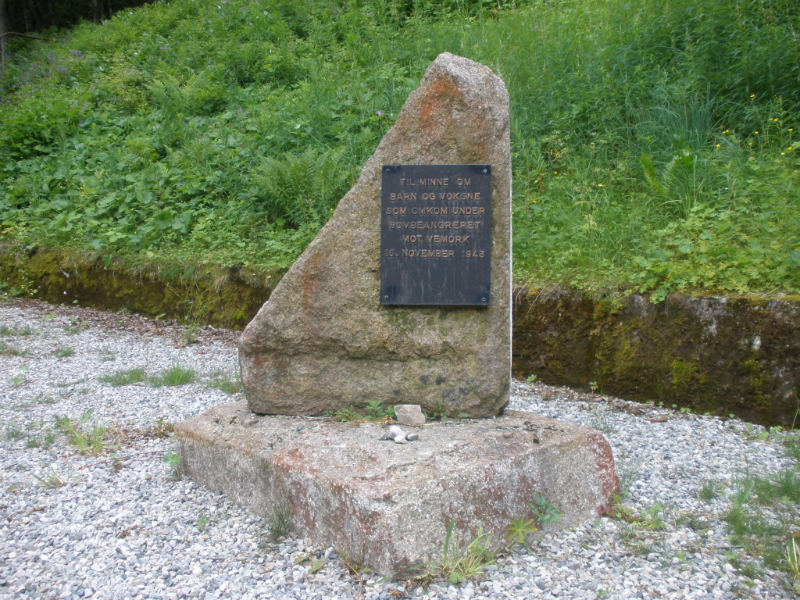 This monument is in memory of the civilians who lost their lives during the bombing of the heavy water plant on November 16th, 1943. Source: Lammert Melk.
This monument is in memory of the civilians who lost their lives during the bombing of the heavy water plant on November 16th, 1943. Source: Lammert Melk.Epilogue
After the war, it was argued that in hindsight, the sabotage had had little use because the Germans had not been able anyway to develop an atomic bomb. After the capitulation, it became clear that their research had not progressed very far but during the war, the Allies had no way of knowing this. The Allies had little intelligence on this and they also were unable to obtain any. The Americans had considered sending a spy to the Third Reich to try and obtain information on the progress of German nuclear research. This plan was abandoned as it was argued that in case such a spy would have been sent, he should have been someone with a broad knowledge of physics and who also should be aware of American progress in the field of nuclear physics. If he was arrested, he could have divulged a lot of secrets to the Germans, informing them of American progress. For this reason, the Americans were convinced for a long time the Germans were way ahead of them and therefore, understandably, dared to take no risks whatsoever.
It is difficult to envisage what would have happened if the production of heavy water had not been sabotaged. Fact is, if the Third Reich had managed to produce an atomic bomb, the consequences would have been catastrophic. Early 1945, Germany had 132.06 gallons of heavy water at her disposal which is not enough for a nuclear reactor though. Calculations show that a minimum of 11.023,11 lbs of heavy water would be required for this. Other sources argue by the way that Albert Speer, Minister of Armament, had given little priority to the German bomb project as early as the beginning of 1942 as it transpired it would take a long time before any results could be expected. According to historians Gitta Sereny and Ian Kershaw, the fact that Germany was experiencing a major shortage of raw materials at the time also played a role in this decision. The research continued until the end of the war. Kurt Diebner, one of the scientists involved, stated after the war that he was convinced that if production had not been sabotaged, he would have had enough heavy water to build a reactor by the end of 1943. "The destruction of deuterium production in Norway is one of the main reasons why Germany never managed to obtain any," he later wrote in his memoirs. Moreover, in June 1942, German scientists had succeeded in achieving an increase in neutrons. But their experiment was not continued after an accident."
There cannot be any doubt as to the courage of the men who took part in this. When Winston Churchill (Bio Churchill) read the reports on the operation he urged for decorations of "these brave men". Haukelid and Rönneberg were awarded the Distinguished Service Order. The other members of the team were awarded the Military Medal. Skinnarland was awarded the Distinguished Service Medal for his contribution. All Norwegians who had participated were awarded the Kriegskorset med Sverd (war cross with sword), Norwegian’s highest military decoration. They had made an extraordinary achievement in very difficult circumstances. Many historians such as Antony Beevor and Max Hastings consider it the most successful sabotage action of World War Two. Antony Beevor states about this: "German scientists were a long way from being ready to produce an atomic weapon but the Allies could not take the slightest risk in this field. As it was, both Vemork operations were the most successful acts of sabotage of the entire war."
Operation Gunnerside has been the source of many books and movies. As early in 1948, a Norwegian-French film was launched entitled "Kampen om tungtvannet." Conspicuously, many actors played themselves, including Poulsson and Kjelstrup. In 1965, a British film was launched: "Heroes of Telemark" which has little to do with the truth. In reaction to this, the BBC published a documentary in 2003: "The real heroes of Telemark." In it, the true story is told with the emphasis on the winter Poulsson and his companions spent on the Hardanger plateau. The commandoes who were still alive at that time, contributed to the movie. In 2015, a miniseries was published in Norway with the same title as the movie of 1948 in which the story was told anew. The English title reads "The heavy water war". In 2010, the Swedish heavy metal band Sabaton dedicated their song "Saboteurs" to the operation.
Syverstad and Tronstadt were killed in a fire fight against German troops on March 11th, 1945 during an S.O.E. operation in Norway. The other participants in Operation Gunnerside and the sinking of the Hydro would survive the war. Idland died in 1968, Haukelid in 1994, Kjelstrup and Storhaug in 1995 and Einar Skinnarland in 2002. Helberg died March 6th, 2003, right after the 60th anniversary of Operation Gunnerside which was attended by all commandoes still alive. Lier-Hansen died in 2008, Haugland and Kayser in 2009, Poulsson in 2011 and Strömsheim in 2012 at the age of 101. Joachim Rönneberg was the last of the participating commandos to die. He died on October 21, 2018 at the age of 99.
Definitielijst
- capitulation
- Agreement between fighting parties concerning the surrender of a country or an army.
Images
Information
- Article by:
- Wesley Dankers
- Translated by:
- Arnold Palthe
- Published on:
- 09-02-2017
- Last edit on:
- 30-09-2024
- Feedback?
- Send it!
Related sights
Related books
Sources
- BASCOMB, N., De wintervesting, Hollands Diep, Amsterdam, 2020.
- BEEVOR, ANTONY, De Tweede Wereldoorlog, Ambo, Amsterdam, 2012.
- GALLAGHER T., Saboteer Hitlers atoombom!, Amsterdam Boek, Amsterdam, 1976.
- HASTINGS, M., De geheime oorlog, Hollands Diep, Amsterdam, 2015.
- JACOBS, P., Heldhaftige missies in WOII, Karakter Uitgevers B.V., Uithoorn, 2016.
- MILTON, G., Churchills ministerie van onfatsoenlijke oorlogsvoering, Karakter Uitgevers B.V., 2018.
- ROSSEM, VAN, MAARTEN, De Atoombom, Home Academy Club, 2009.
